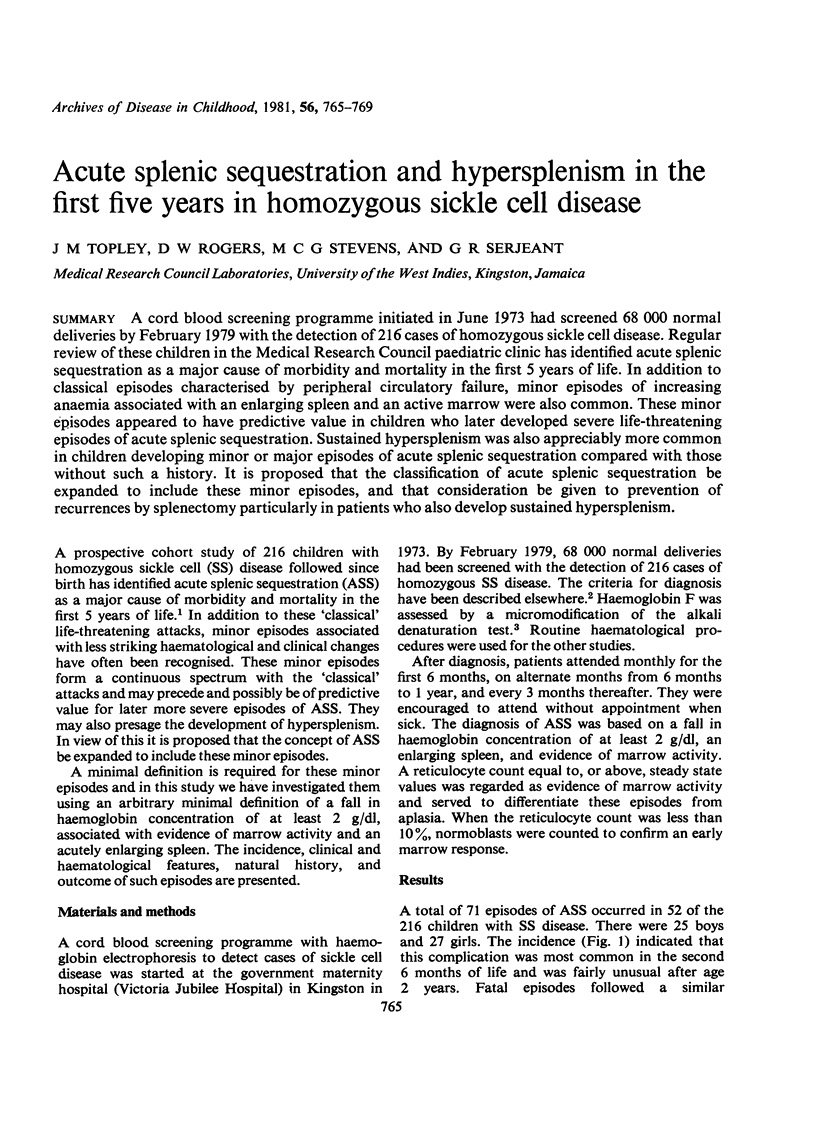Abstract
A cord blood screening programme initiated in June 1973 had screened 68 000 normal deliveries by February 1979 with the detection of 216 cases of homozygous sickle cell disease. Regular review of these children in the Medical Research Council paediatric clinic has identified acute splenic sequestration as a major cause of morbidity and mortality in the first 5 years of life. In addition to classical episodes characterised by peripheral circulatory failure, minor episodes of increasing anaemia associated with an enlarging spleen and an active marrow were also common. These minor episodes appeared to have predictive value in children who later developed severe life-threatening episodes of acute splenic sequestration. Sequestration. Sustained hypersplenism was also appreciably more common in children developing minor or major episodes of acute splenic sequestration compared with those without such a history. It is proposed that the classification of acute splenic sequestration be expanded to include these minor episodes, and that consideration be given to prevention of recurrences by splenectomy particularly in patients who also develop sustained hypersplenism.
Full text
PDF




Selected References
These references are in PubMed. This may not be the complete list of references from this article.
- Casper J. T., Koethe S., Rodey G. E., Thatcher L. G. A new method for studying splenic reticuloendothelial dysfunction in sickle cell disease patients and its clinical application: a brief report. Blood. 1976 Feb;47(2):183–188. [PubMed] [Google Scholar]
- JENKINS M. E., SCOTT R. B., BAIRD R. L. Studies in sickle cell anemia. XVI. Sudden death during sickle cell anemia crises in young children. J Pediatr. 1960 Jan;56:30–38. doi: 10.1016/s0022-3476(60)80285-5. [DOI] [PubMed] [Google Scholar]
- Pearson H. A., McIntosh S., Ritchey A. K., Lobel J. S., Rooks Y., Johnston D. Developmental aspects of splenic function in sickle cell diseases. Blood. 1979 Mar;53(3):358–365. [PubMed] [Google Scholar]
- Pearson H. A., Spencer R. P., Cornelius E. A. Functional asplenia in sickle-cell anemia. N Engl J Med. 1969 Oct 23;281(17):923–926. doi: 10.1056/NEJM196910232811703. [DOI] [PubMed] [Google Scholar]
- Rogers D. W., Clarke J. M., Cupidore L., Ramlal A. M., Sparke B. R., Serjeant G. R. Early deaths in Jamaican children with sickle cell disease. Br Med J. 1978 Jun 10;1(6126):1515–1516. doi: 10.1136/bmj.1.6126.1515. [DOI] [PMC free article] [PubMed] [Google Scholar]
- Seeler R. A. Deaths in children with sickle cell anemia. A clinical analysis of 19 fatal instances in Chicago. Clin Pediatr (Phila) 1972 Nov;11(11):634–637. doi: 10.1177/000992287201101111. [DOI] [PubMed] [Google Scholar]
- Serjeant B. E., Clarke J. M., Desai P., Serjeant G. R. A simple micromethod for the measurement of fetal haemoglobin. J Clin Pathol. 1975 Sep;28(9):761–764. doi: 10.1136/jcp.28.9.761. [DOI] [PMC free article] [PubMed] [Google Scholar]
- Serjeant B. E., Forbes M., Williams L. L., Serjeant G. R. Screening cord bloods for detection of sickle cell disease in Jamaica. Clin Chem. 1974 Jun;20(6):666–669. [PubMed] [Google Scholar]


